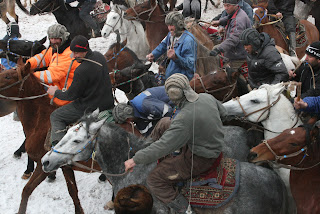 |
| A family shows food preserved using improved techniques. |
Last month Gazprom announced that it had discovered approximately 60 billion cubic meters of natural gas, or the equivalent of 50 years worth of domestic use. This is good news for a country that has become so reliant on natural gas for heating from Uzbekistan that during periods of chilly relations or delayed payments, supply has been suspended causing untimely deaths for some of Tajikistan’s population.
This is in addition to the massive hydroelectric project currently underway at Rogun Dam that is expected to help make Tajikistan a net energy exporter to countries like Pakistan and Afghanistan in the near future. And Rogun is not the only hydroelectric project planned for this glacier-rich country.
Also, just this month, two new gold deposits were found in central and north Tajikistan, totaling 117 tons and 59 tons respectively. With the help of Chinese mining companies, these deposits could help increase Tajikistan’s current 1.3-1.5 ton production annually.
So I mention the Chinese.
China has made immense investments in Central Asia in recent years. As the global leader in energy consumption, China has been furiously looking for other sources to fuel its economy. China has provided $10 billion to Kazakhstan to help boost its economy in exchange for a construction of a pipeline that is expected to carry 400,000 barrels of oil per day to China. There are already 15 majority Chinese companies in Kazakhstan. The Chinese have even overtaken Russia’s influence in Kazakhstan with Chinese companies importing 18 million tons of oil from Kazakhstan in 2009, compared to just 6.4 million tons by Russian companies.
In Turkmenistan it’s the same story, with China already signing contracts to purchase up to 40 billion cubic meters of Turkmen gas annually. This is after $7 billion of approved soft loans to Turkmenistan in order to develop specific gas deposits.
So what does this mean for Tajikistan? Well, the Tajik government just announced that it was going to lease land on Tajik soil to allow 1,500 Chinese farmers to grow food for the Chinese. This is certainly disconcerting in a country that has difficult producing enough food for its own people. The government has given the justification that the Chinese will bring with them contemporary farming techniques and develop land that has been left fallow due to labor shortages from labor migrations to Russia. People in Tajikistan aren’t so sure.
One issue is the fact that this means a large incursion of Chinese into the country to work the fields. There were 30,000 Chinese migrant laborers in Tajikistan in 2007 working on roads and mining sites. This number had jumped to 82,000 by 2010. This is likely to expand rapidly with this new deal in Tajikistan – a reality that does not sit well with many in Tajikistan.
This new deal comes right on the heels of an announcement that Tajikistan had ceded 1,100 square kilometers of Tajik land (1 percent of the country’s total land area) to China.
With China’s rapidly growing influence and investment in the region, one has to ask what the benefits will be. With Chinese laborers building these projects keeping employment from a Tajik population of young people desperately in need of work and with land being leased or ceded to China for food production in a country that has periods of high food insecurity, investment may come at a net cost to the people of Tajikistan.
Articles of Interest
http://www.rferl.org/content/tajikistan_china/2289623.html
http://www.atimes.com/atimes/Central_Asia/MA14Ag01.html
http://www.rferl.org/content/beijing_stealthy_expansion_central_asia/2274062.html
http://business.inquirer.net/money/breakingnews/view/20110113-314153/Tajikistan-discovers-two-large-gold-deposits
http://www.neurope.eu/articles/104060.php















































